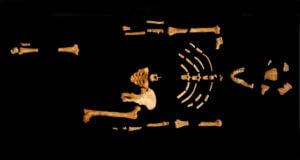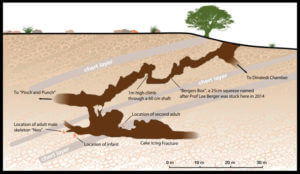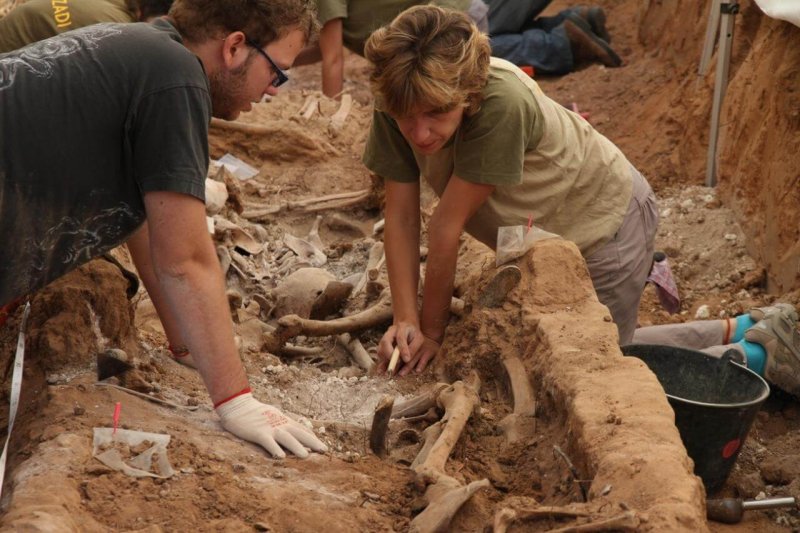People used to joke that there were more paleoanthropologists than there were fossils of our human ancestors. They also said that if you have two paleoanthropologists in the room, there will be four or five opinions. The study of extinct hominins — human species other than our on modern Homo sapiens— traditionally has been a rather opinion-heavy science, characterized by a dependence on a small number of fossil specimens — such a small number that excavation of just one new partial skeleton could change the field dramatically. One famous example is Lucy — several hundred pieces of bone comprising about 40 percent of a skeleton of the species Australopithecus afarensis — whose discovery in the early 1970s demonstrated that our ancestors started walking upright, before they started to grow large brains.
More recently came news of another discovery that changed everything. Jebel Irhoud is a site in Morocco that has been under study since 1961, but new specimens of early H. sapiens, and some tools, led to a significant paper in the journal Nature from a team of scientists at top institutions in Europe, Morocco, the United States and the United Kingdom. This time, we’re not looking back millions of years to the time A. afarensis, but merely a few hundred thousand years to the origins of our own species. The take-home message is that H. sapiens is at least 300,000-years old, and that our cradling was a pan-African phenomenon, rather than being isolated to East Africa, as previously thought. It’s a fascinating prospect, but an even bigger story is how today’s paleoanthropologists are able to learn things so much faster than they did in the past.

The past several years has seen an acceleration of discoveries in paleoanthropology, and in popular articles and television programs to keep the pubic informed. What’s happening? Are scientists getting better at finding human remains? The answer is yes, and there are technological reasons for this, but that’s just one of several factors at work. Improved communication and transportation also contribute and, importantly, researchers are now able to do a lot more with less of the materials they do excavate. This has to do with both imaging of samples, and extraction, sequencing, and sequence analysis of DNA.
Knowing where to look
In the 19th and early 20th centuries, paleoanthropologists typically looked for hominin fossils in places that were known to preserve bones and teeth of any mammals, due to the experiences of those who lived there or had visited those sites. But by the mid 20th century, researchers were relying increasingly on integration with other sciences, particular geology, which could provide insight on the forces and conditions likely both to preserve and transport and accumulate animal remains. If you know that an ancient river went this way, or that way, for instance, you might reason that a certain deposit could be a good place to look for fossils. Using Lucy as an example — she was excavated in the Afar Triangle, which is part of East Africa’s Great Rift Valley. By the time Lucy was discovered in 1974, the area was under intense study by geologists and other researchers. This included aerial observation which, along with imaging from space satellites, has become vital to the science of knowing where to look in the first place.
Getting the word out
We live in the age of easy communication and travel, and also a time when many people have intense hobbies — rock climbing and caving, for instance. This came into play a few years ago with the discovery of the species Homo naledi. This is a hominin, with a small brain, like that of A afarensis. The H. naledi remains were found in what’s called the Rising Star Cave system in South Africa, but reaching the fossils required entry through a super-narrow tunnel. A typical researcher could not fit through such a tunnel, so in 2013 the researchers advertised for cavers.

This led ultimately to the recruitment of six cavers, very narrow women who could squeeze through the passage, thereby accessing what initially were estimated to be the skeletal remains of fifteen individuals. It’s now thought to be more like 18 H. naledi specimens, both adults and children, and that there must be more throughout the cave system. It’s a major discovery, because of the unusually high number of specimens found in one location. Additionally, this year, the fossils were re-dated and are now thought to be under 300,000 years old. This has been a major surprise, as it means that, until recently, some form of small-brained, upright walking hominins persisted alongside various other hominins whose brains were evolving to become much larger, and more complex.
Getting more from fossils
The growing number of discoveries in paleoanthropology depends on rapidly improving technology aimed at getting data from the fossils that we do have. Such technologies include high tech imaging and microscopic techniques. Scanning electron microscopy (SEM), for instance, provides 3-D images of cell-sized features in bone, teeth, and other fossilized materials. Similarly, various optical technologies are being used to generate detailed 3-D images from parts of teeth and other fossilized structures. Infrared imaging also is being studied for use on fossils.
DNA-based techniques
Preserved within fossilized bones is DNA whose sequences are used increasingly as molecular fossils, the basis for what is called paleogenetics. From ice cores, DNA has been recovered from plants and insects as old as 800,000 years, but the oldest hominin DNA to be extracted and sequenced is 400,000 years old. Such samples from the site Sima de los Huesos (“pit of bones”) in Spain and the sequencing was done by researchers from the Max Planck Institute, a leading center in paleoanthropology that also played the lead role in the recent Morocco find. The recovered DNA from Sima de los Huesos is mitochondrial DNA (mtDNA), which is one of two categories of DNA that investigators try to extract from bone. The other type is nuclear DNA — DNA from the chromosomes in the cell nucleus.
The age of paleogenetics of extinct human ancestors began in 1997, when researchers were first able to extract and sequence mtDNA from Neanderthal bone. Samples of mtDNA are generally easier to obtain compared with nuclear DNA. That’s because mtDNA comes from the cell power plants, mitochondria, of which there are many time more than nuclei. At the turn of the century, paleogeneticists did not think they would get nuclear DNA from bones tens of thousands of years old, but that has been possible for several years now. Together with what is called next generation sequencing technology, the ability to read both nuclear and mitochondrial DNA sequences has been increasing in leaps and bounds.
Human evolution can be studied though comparison of mitochondrial and nuclear sequences between modern humans and samples extracted from ancient specimens. This has revealed relationships between modern humans, Neanderthals, and another extinct group, the Denisovans. In particular, DNA studies support the idea that an ancestral species —Homo heidelbergensis, which existed by about 700,000 years ago and possessed increased intelligence and capabilities compared with what is called Homo erectus— gave rise to H. sapiens as a few distinct sub-species that co-existed on Earth for several hundred thousand years. This happened as a result of waves of migration out of Africa. A group H. heidelbergensis that went to Europe became the Neanderthals (Homo sapiens neanderthalensis). A different group of migrants went through the Middle East and then on through Asia in a different time period, becoming Homo sapiens denisova. Meanwhile, another variant of H. heidelbergensis evolved into Homo sapiens sapiens –modern humans, but in an archaic form– both throughout and out of Africa.
DNA analysis shows that modern humans, Neanderthals, and Denisovans diverged perhaps 400,000 to 500,000 years ago. However, since we are talking about subspecies, not distinct species, any mating between all the types of H. sapiens could produce fertile children. In other words, though separated by geography, they were not separated long enough for reproductive isolation to diverge their genetics enough to create separate species. Because of the DNA studies, we know that the ancestors of most modern humans mixed occasionally with now extinct subspecies. Last year, the New York Times reported on a study published in Science revealing that there were a minimum of four times when genes from Neanderthals, Denisovans, or other extinct human species, entered the modern human gene pool. The exception is the gene pool in sub-Saharan Africa, since there were no Neanderthals or Denisovans that far south, but what this reveals is a picture of the origins of modern humans a little more sloppy than what researchers had in mind a few decades ago. It’s not something that one could derive purely from the form of the bones, even with advanced imaging, and it may be an indication of the increasing role that genetics will play as paleoanthropology moves forward.
David Warmflash is an astrobiologist, physician and science writer. Follow @CosmicEvolution to read what he is saying on Twitter.































